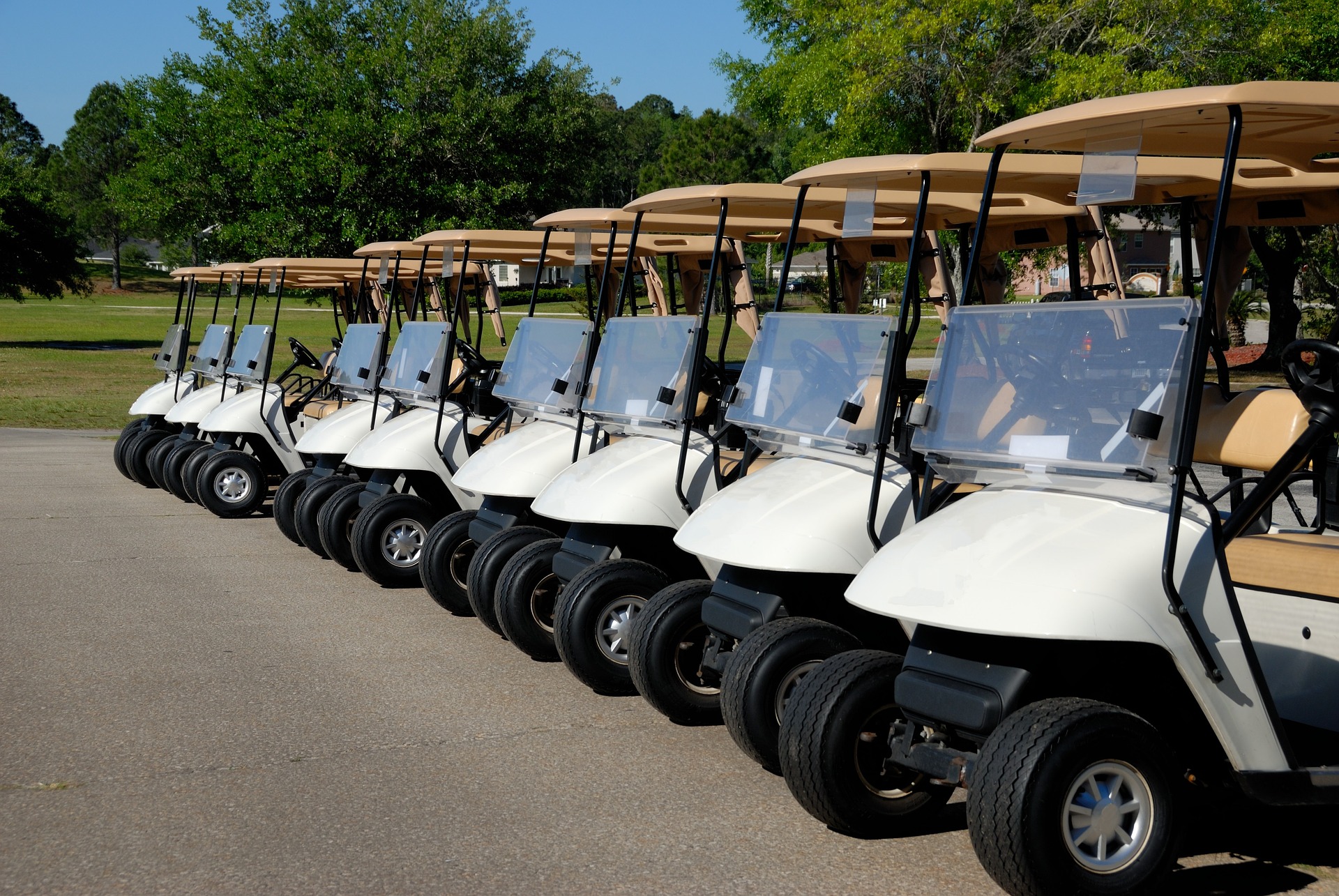
There are a variety of battery sizes and kinds for electric golf carts. Golf carts aren’t just used by golfers anymore. The electric golf cart is a familiar sight in many coastal towns and retirement communities. To keep the resorts, zoos, and parks they serve clean and odorless, they’re often utilized as maintenance vehicles for gas-powered vehicles.
You probably don’t give much thought to the batteries in your golf cart, but understanding how they function and preserving them is crucial to the operation of your cart. An electric golf cart’s top speed, acceleration, and range are all determined by the battery system it uses.
Any golf cart can assist you to travel about the course or neighborhood, but be sure it has adequate power for the task. Lithium-ion batteries for golf carts come in handy in this situation. A variety of advantages, including ease of maintenance and lower long-term costs, have made them a serious competitor to other battery types.
Golf Cart Batteries: What Are They?
With an average speed of 15 miles per hour, electric golf engines typically run at 36 or 48 volts and 50-70 amps of electricity. During acceleration or when traveling up a hill, the current draw is substantially higher. Golf cart batteries must be able to maintain a continuous flow of high current for a lengthy period of time in order to prevent you from becoming stuck.
Golf cart batteries, on the other hand, often undergo a full charge and discharge cycle every day. If a battery is drained to less than 50% capacity, it is likely to have a shorter life expectancy and work less efficiently.
Golf cart batteries are deep-cycle batteries developed and manufactured to withstand continuous current demand and repeated deep draining. As a rule, they may be connected in series to supply the appropriate voltage in 6, 8, or 12-volt combinations. When four 12-volt batteries are linked in series, the output is 48 volts, and six 6-volt batteries can deliver that.
Lithium-ion Batteries in golf carts
Deep-cycle lithium iron phosphate (LiFeO4) batteries are used in golf carts. Don’t mix these with the lithium batteries often seen in tiny electrical devices. ‘ Lithium iron phosphate (LiFeO4) batteries are among the safest and most reliable Li-ion battery types. They are designed to maintain a constant current output throughout time.
In the following, we’ll go through the benefits of using lithium golf cart batteries.
Carrying Capacity
The weight-to-performance ratio of a golf cart may be dramatically improved by using lithium-ion batteries for golf carts. Compared to standard lead-acid batteries, lithium golf ion batteries for golf carts weigh half as much. This means that a golf cart can run with a battery weight that is two-thirds lighter. Because of its reduced weight, the golf cart is able to travel at greater speeds and carry more weight without seeming slow to the people within.
In addition to two average-sized persons and their gear, the lithium-powered cart can transport an additional two people due to the weight-to-performance ratio differential. In contrast to lead-acid batteries, lithium-ion batteries retain a constant voltage output regardless of the battery’s charge, allowing the cart to work even when it falls behind the pack. As a result, lead-acid and Absorbent Glass Mat (AGM) batteries lose performance and voltage output when 70-75 percent of their stated capacity is consumed, which has a negative impact on carrying capacity and worsens as the day goes on.
No upkeep is required
Lithium battery maintenance is not required for lithium batteries. In the end, this saves time and money spent on equipment and supplies for maintenance. Due to the absence of lead-acid batteries, chemical leaks are prevented, which reduces downtime on your golf cart.
Longer Lifespan and Warranty
It is common for lithium batteries to live between five and 10 times longer than lead-acid ones. lithium batteries are deep-cycle batteries that have minimal influence on their lifespan when they are charged and discharged repeatedly.
Battle A 10-year guarantee is standard for new lithium batteries. Compare this to lead-acid batteries, which typically come with a one- to the two-year guarantee.
More Energy Efficient
Compared to lead-acid batteries, lithium-ion batteries offer a more even voltage distribution. Typically, lead-acid batteries may only be depleted to roughly 50% of their capacity before the voltage drop becomes too high and your golf cart dies.
Lithium batteries, on the other hand, maybe discharged practically to zero voltage loss. This implies that each time you recharge a lithium battery, you’ll be able to get the most out of it.
Moreover, lithium golf cart batteries may be fully charged in roughly two hours, compared to lead-acid batteries, which is a substantial improvement.
Eco-Friendly
Lithium-ion batteries have a lower environmental impact. They use less energy since they require less time to charge. They are safe for the environment.
Are Lithium-ion Golf Cart Batteries Compliant?
A lithium-ion battery upgrade can significantly improve the performance of golf carts that were originally built to run on lead-acid batteries. However, this new lease of life may come at a price. In order to use a lithium-ion battery on an existing lead-acid golf cart, a retrofit kit is required, and if the cart manufacturer doesn’t provide a kit, the cart will need adjustments.
Considerations Before Making A Decision On A Lithium Golf Cart Battery
Size of the Battery
When switching to lithium-ion batteries for golf carts, be sure you’re getting a battery that can simply be swapped in for your existing one. Lead-acid golf cart batteries typically come in the GC2/GC8 group size.
Next, figure out how many volts you need in your battery. Because the batteries are linked in series, you have the option of adding more to meet your power requirements. Using six 8-volt lead-acid batteries is necessary to achieve the 48-volts needed to power your car. Batteries come in a variety of capacities, but once you pick one, you’re stuck with it unless you change the complete battery pack. Because the battery set has 170 Amp-hours installed, you are committing to that capacity for the rest of your life.
Need Of Battery Spacers
The use of battery spacers may be necessary if you use a lithium solution that is the same GC2 size as your lead-acid batteries. When installing real drop-in replacement batteries, such as RELiON’s InSight 48V batteries, battery spacers are utilized to fill the empty battery slots.
Consider purchasing InSight 48V lithium battery if you’re thinking about using a lithium battery in your golf cart. For the first time, a lithium-ion battery particularly intended for golf carts has been developed. It’s a high-quality, ready-to-install replacement. There are currently no better lithium-ion golf cart battery options than InSight’s.
How to Charge Lithium-Ion Battery
When you switch to lithium batteries for your car, you’ll also need a charger. When deciding on a charger, there are a few things to double-check. Check the voltage setpoints on your charger or the charge profile you’re using to make sure it’s suitable for lithium batteries. Your lithium battery and charger should be preloaded with a suitable algorithm in order to get the most out of your device.
You may also like our article about Graphene batteries


Yes, it is true and I agree with you. Lithium batteries can be charged faster and last longer than lead-acid batteries. They are also lighter in weight and have a lower discharge rate. Lithium is also environmentally friendly and has a higher energy density than lead acid, which means it can power a golf cart for longer distances. Thank you for sharing this blog with us. It is very informative.